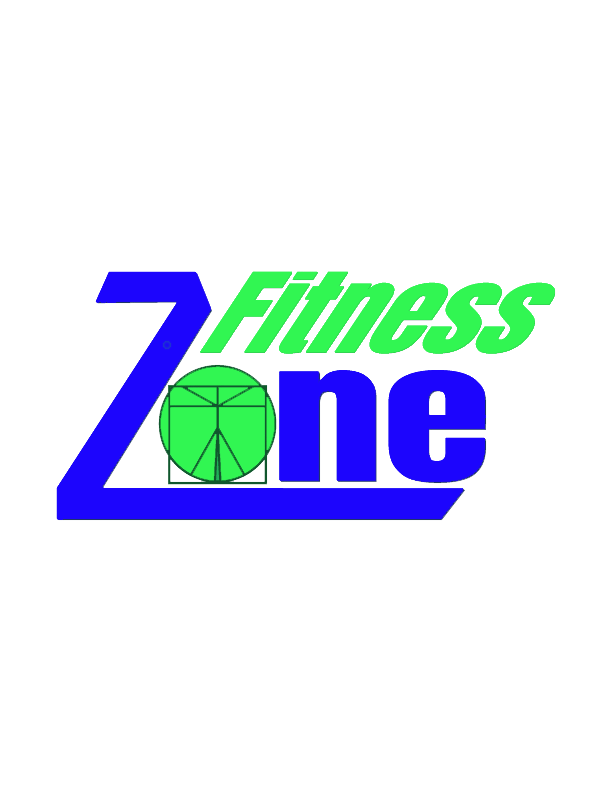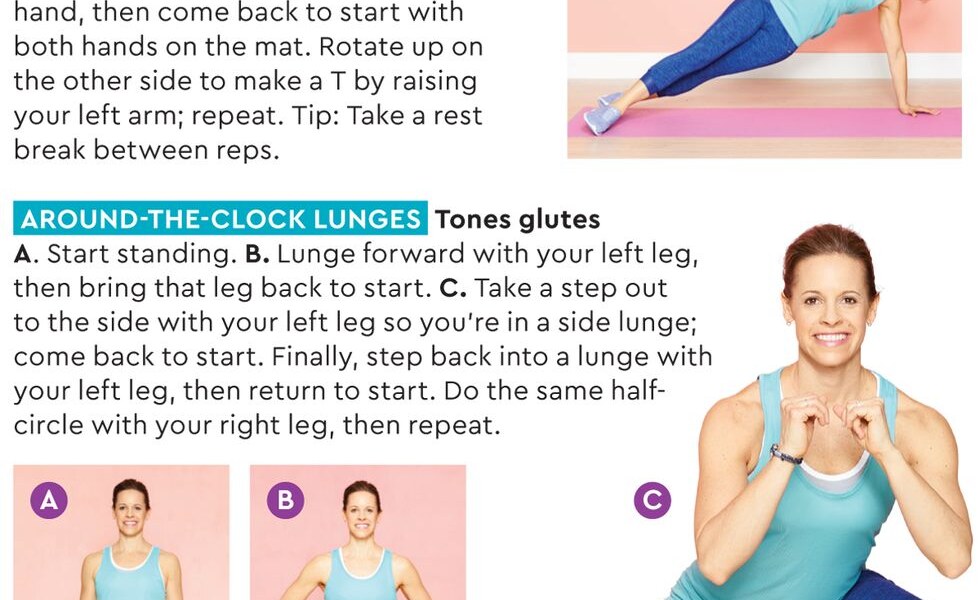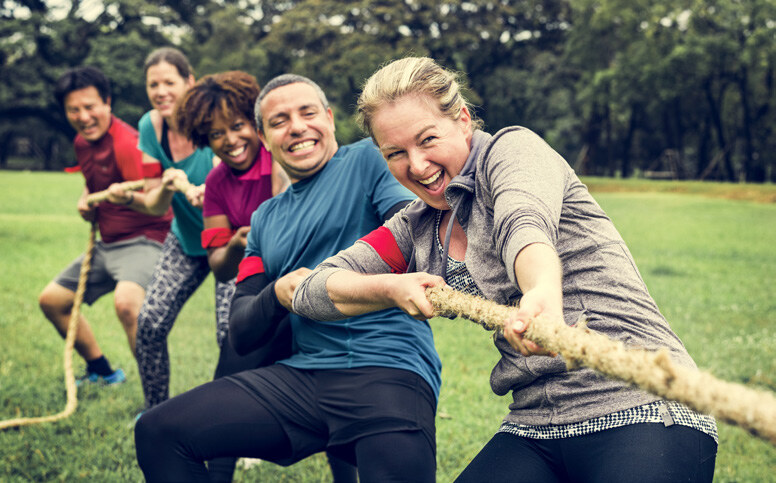Fall fitness time! I’ve noticed that parking at my gym in the mornings has become a bit more of challenge the last couple weeks. The weather is cooling off, school has started, and people are finding their way back to the gym. Indoor exercise always seems to pick up in the fall.
How can I begin fall fitness when I head back to the gym?
If you have been active this summer, this becomes a much easier question to answer. You can probably jump back into any routine you have used previously and see success/progress. Modifying weight and some of the exercises may be necessary to start, but you’ll be back to feeling comfortable and confident in no time.
If you haven’t been as active this summer, for whatever reason, getting back to the gym can be a much more daunting task. Scheduling time can be a limiting factor and soreness is inevitable.
Regardless of which group you are in, the following are key to your success back at the gym:
- Set reasonable, SMART Goals. These goals will help motivate you. SMART Goals are:
- Specific
- Measurable
- Achievable
- Relevant
- Time Bound
- Resistance training is important but remember to start off easy. Jumping back into an old routine at the levels that you were at before can cause excessive soreness or injury.
- Cardio in the gym or an indoor setting is different than some of the cardio that you’ve been doing outside. Gym equipment is less modifiable for individual stride lengths and foot placements. Make sure you are setting the gym equipment to the right settings for your height and weight.
- Flexibility is the key to success. Mobility exercises are very important as you get back into your gym routine. They help with eliminating soreness but also help protect us from injury and can also be a very good active warmup or cool down.
- Variety is important. Variety is important for several reasons as you get back into exercise. From preventing overuse injury to keeping us interested and motivated, variety is key.
Our individualized exercise plans evolve throughout the year. As your fall fitness program changes, make sure it changes in a smart, fun and appropriate way. Remember that there is no perfect exercise, exercise machine, or workout plan that works for everyone. There is though, a great plan out there that’s perfect for you. Good luck in finding that perfect plan!
Was your fitness routine pretty much nonexistent over the summer season?
From holidays, to amusement park visits, to the pool… Summer holidays are go go go go! Combine this with not eating very well, drinking too much alcohol and really having no time to yourself and you’re left feeling drained and far from your best!
Well, time to get excited… It’s back to school time!
This means many hours of uninterrupted ‘ME’ time (lol!). Time to plan on not only using this time to work, but to workout and really making fitness and your self-care a HUGE priority for yourself.
I know that kids activities will soon begin to fill up your calendar so to help fit in some ‘me’ time too, I have come up with some tips for making fitness time a reality so you can be a healthier mama.
MAKE A LIST OF WORKOUTS THAT INTEREST YOU
No one wants to do something that’s boring and working out is no exception to this. In order to keep your motivation up, you need to find things that are fun for YOU.
Whether you can go to a gym or you have to workout at home, there are PLENTY of workouts to choose from.
SCHEDULE YOUR WORKOUTS
Just like anything in life, if you don’t make time for it, chances are it’s not going to happen. At the beginning of your week schedule in WHEN you’ll be working out. Whether it’s first thing in the morning or after the kids are in bed, write it down and stick with it!
IF YOU CAN’T DO A BLOCK, SCHEDULE MINI WORKOUTS
This is something I love to do. Even though I’d much rather go and workout for a hour and be done with it, sometimes that just isn’t possible, so on these days, I like to do a bunch of mini workouts, 10-15 minutes at a time that I can slot into the day. All calories burned will add up so just because you have endless appointments or tons of work to do, don’t let that discourage you from getting a workout in. A few minutes are better that nothing!
GET YOUR FRIENDS INVOLVED
If you have mom friends that are home during the day, get together a group of them (or even just one!) and help to keep each other motivated. Go to a class together or go walk in the park – anything is more fun with friends!
PLAN OUT YOUR MEALS
You plan your kid’s lunches out for school, right? So why should yours be any different! Make a “healthy lunch” board on Pinterest and start spicing up your own lunch routine with some healthy salads, sandwiches or smoothies that will fill your body with the protein and vitamins you need to get through your whole day.
I don’t know about you, but I am thrilled to get back to my fitness routine, and having my kids back in school is going to be the best way for me to get back to being healthier and more fit.
After you’ve completed week one of the summer-shape up plan, continue with this calorie-burning routine. Start by doing each move for 1 minute, rest for 30 seconds, then repeat twice for 6 minutes of activity. Bonus: Take a 20-minute walk before your workout for more benefits!
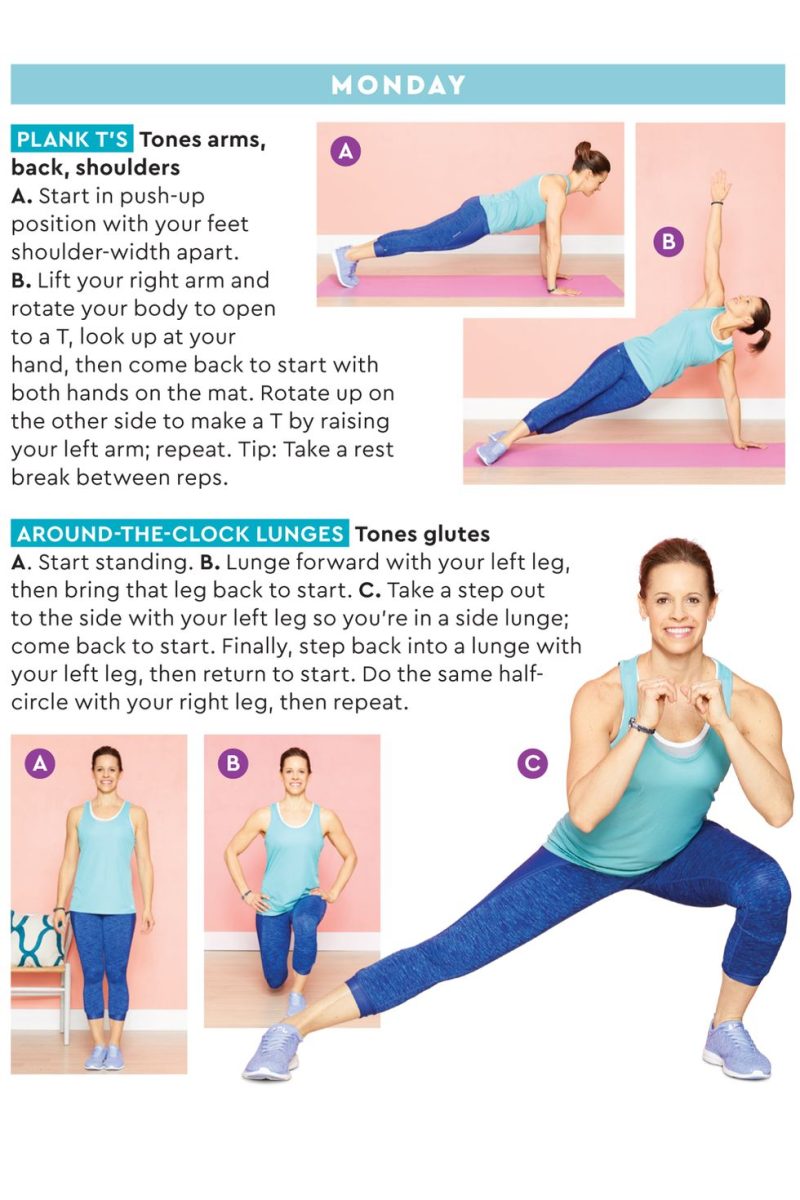
Plank T’s: Tones arms, back, shoulders
A. Start in push-up position with your feet shoulder-width apart. B. Lift your right arm and rotate your body to open to a T, look up at your hand, then come back to start with both hands on the mat. Rotate up on the other side to make a T by raising your left arm; repeat. Tip: Take a rest break between reps.
Around-the-Clock-Lunges: Tones glutes
A. Start standing. B. Lunge forward with your left leg, then bring that leg back to start. C. Take a step out to the side with your left leg so you’re in a side lunge; come back to start. Finally, step back into a lunge with your left leg, then return to start. Do the same half-circle with your right leg, then repeat.

Tuesday
Crab Kicks: Tones arms, back, legs, glutes
Come into a tabletop position with your hands and feet on the floor and your torso lifted. Kick your right leg up, lower, then repeat on the left. Make sure you straighten your arms and squeeze your glutes.
Jumping Jacks: Tones legs, arms
Stand with your feet close together, arms by your sides. Bring your arms over your head while you hop your legs out. Hop your legs together while bringing your arms back down by your sides; repeat.
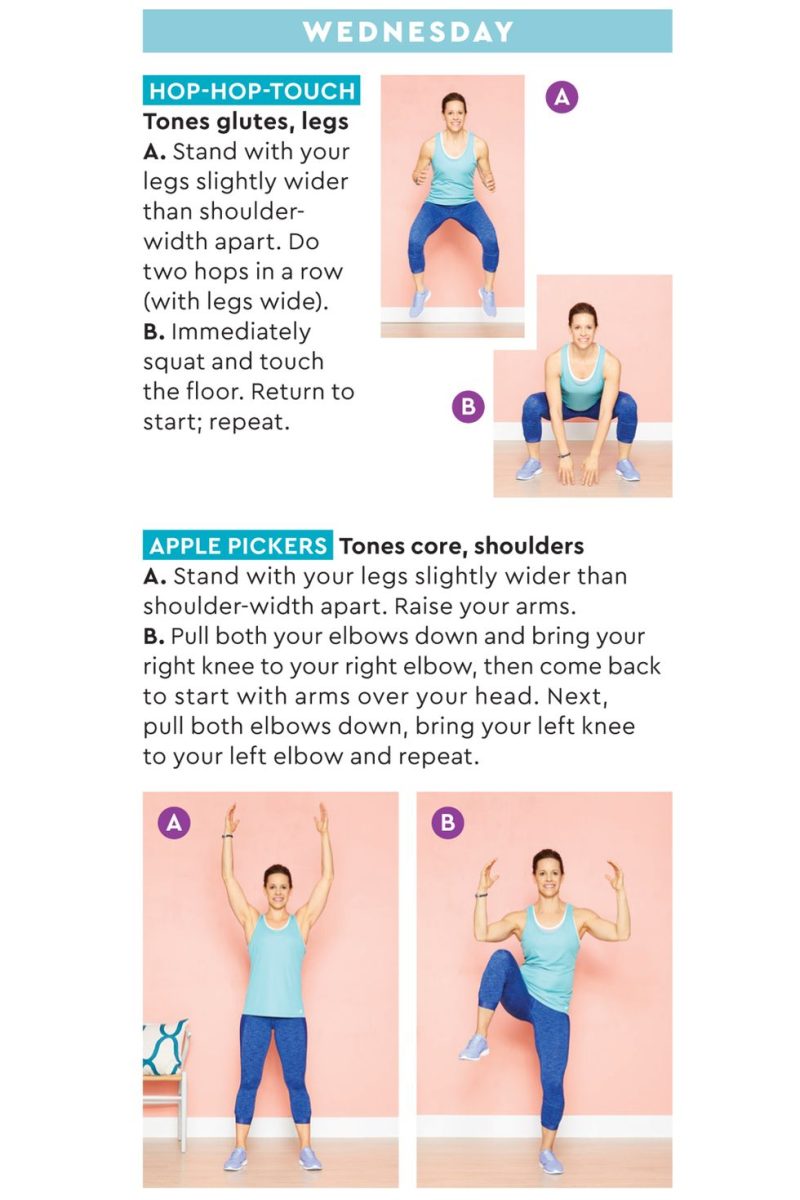
Wednesday
Hip-Hop-Touch: Tones glutes, legs
A. Stand with your legs slightly wider than shoulder-width apart. Do two hops in a row (with legs wide). B. Immediately squat and touch the floor. Return to start; repeat.
Apple Pickers: Tones core, shoulders
A. Stand with your legs slightly wider than shoulder-width apart. Raise your arms. B. Pull both your elbows down and bring your right knee to your right elbow, then come back to start with arms over your head. Next, pull both elbows down, bring your left knee to your left elbow and repeat.
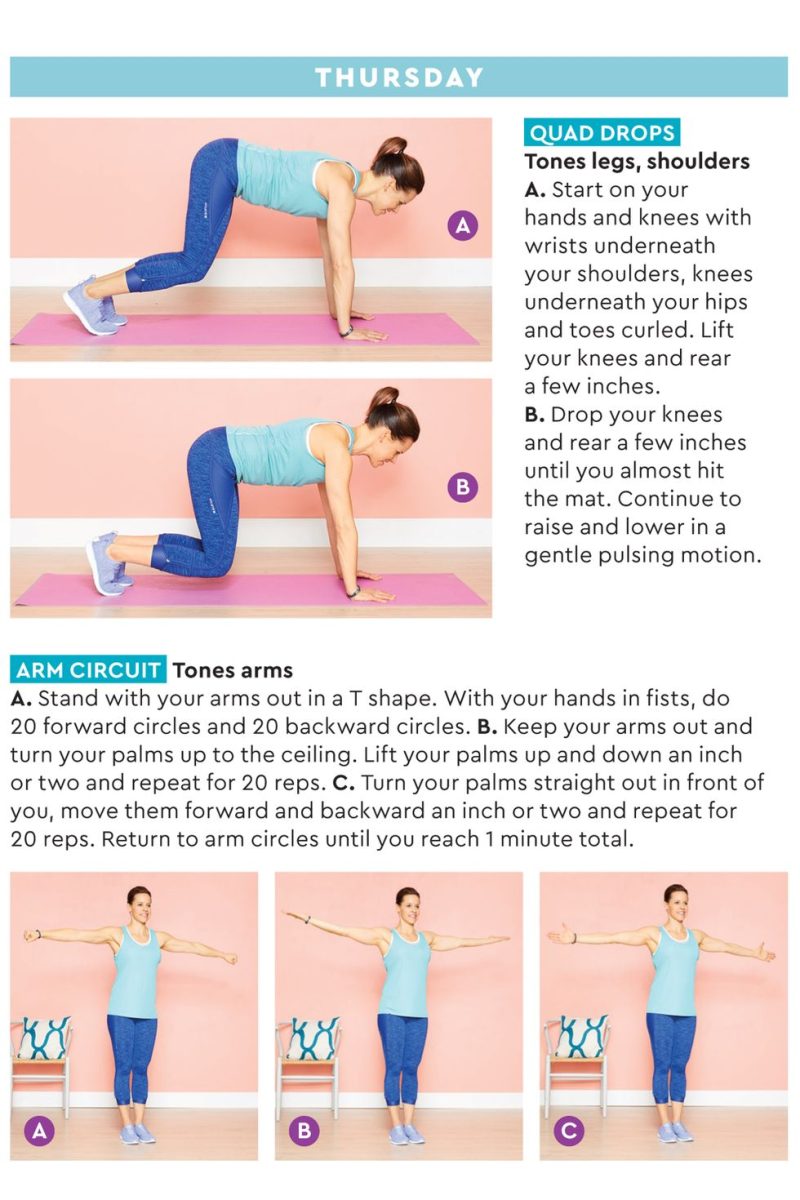
Thursday
Quad Drops: Tones legs, shoulders
A. Start on your hands and knees with wrists underneath your shoulders, knees underneath your hips and toes curled. Lift your knees and rear a few inches. B. Drop your knees and rear a few inches until you almost hit the mat. Continue to raise and lower in a gentle pulsing motion.
Arm Circuit: Tones arms
A. Stand with your arms out in a T shape. With your hands in fists, do 20 forward circles and 20 backward circles. B. Keep your arms out and turn your palms up to the ceiling. Lift your palms up and down an inch or two and repeat for 20 reps. C. Turn your palms straight out in front of you, move them forward and backward an inch or two and repeat for 20 reps. Return to arm circles until you reach 1 minute total.

Squat Front Kicks: Tones glutes, legs
A. Stand with your legs shoulder-width apart. Squat. B. Kick forward with your right leg as you come up. Bring that leg back so you’re standing on both feet, then squat and kick with your left leg. Repeat.
Knee Tucks: Tones shoulders, core
A. Start in a downward dog position (hands and feet flat on the ground, rear in the air, so your body makes a V shape). B. Come forward into a push-up position and bring your right knee toward your chest. Hold for 10 seconds, then bring your knee back and return to downward dog. Do the same on the left and repeat.
10 Commandments of Fatherly Fitness
Once upon a time I was a badass. Ran a sub-six-minute mile. Benched over 300. Competed in kickboxing and jiujitsu and won. I was high speed, low drag, and aerodynamically efficient. But that was once upon a time.
Being a grownup changed all that. More hands on my time left less time for the gym. A body in its 40s doesn’t build muscle or burn fat like the one I had two decades ago. My joints hurt more. Everything takes longer to recover from.
But that’s no reason to give up on fitness. Study after study, after study demonstrate that our bodies are a “use it or lose it” situation. The longer we stay active, the longer we remain able to stay active.
In the vein of “I make mistakes so you don’t have to,” here are 10 commandments of fitness for men as they enter middle age. If you follow them, your body will thank you well into retirement.
1. Thou shalt not skip the fitness warmup
As we age, our muscles and tendons become less flexible and more subject to injury. A solid 10- to 15-minute warmup of light motion (not static stretching, which can actually cause damage when done cold) helps counteract that unavoidable truth. It’s time to start thinking of the warmup not as a thing you do before the workout, but rather the first part of the workout.
2. Thou shalt not be too busy for fitness
Middle age is a demanding time. Kids, a spouse, a job, your community, and maybe a minute for a hobby conspire to leave very few hours in the day for you to spend on fitness. But you have to make it happen. Here are a couple of strong options:
- Exercise early in the morning, before things go wrong with your day that could impinge on your workout time.
- Make exercise a necessary part of your daily routine. For example, bicycle to work.
- Exercise with your family (I do jiujitsu with my son) to combine quality time with exercise.
- Find a workout buddy who will harass you into showing up even when it’s hard.
3. Thou shalt focus on flexibility
Flexible muscles and resilient joints will prevent you from sustaining a sidelining injury you may not fully recover from. The best way to insure them is to build in a cooldown stretching routine lasting 10 to 20 minutes at the end of your workout. Stretching while muscles are warm is a flexibility-force multiplier. Take advantage of it.
4. Thou shalt not ignore it
Two advantages of being a grown adult are (often) having decent health insurance and being old enough that your doctor will listen to you. If you experience pain, go get it checked out. The days of “walking it off” or “no pain, no gain” are behind us, gents. Pain is instead a warning that we’re about to get broken.
5. Thou shalt shift your fitness workouts
Those manly, crazy workouts of our 20s are no good anymore. One-rep maxes, rounds in the right, lifting tractor tires like Rocky are still within our capacity, but we pay for them with soreness and injuries.
Instead, focus on medium-weight, medium-rep exercises with large ranges of motion. Good calls include:
- kettlebells
- yoga
- barbell exercises
- swimming
- certain martial arts
These exercises produce exactly the kind of strength and flexibility your older body needs.
6. Thou shalt not prove it
Whatever your exercise, it’s going to happen. Some 20-something who’s almost as good as you used to be is going to be in class, on the gym floor, or in the next lane over. You’ll be overcome with the impulse to show that you’ve still “got it.” And you might even win.
But you up your chances of injury exponentially when you do so. Even if you get away clean, your muscles will be sore and fatigued for as much as a week afterward, which limits how good your next few workouts can be.
7. Thou shalt put fitness competition behind you
Friendly contests are fine, but resist the urge to enter into serious athletic competitions. It’s simply asking for injury.
This commandment is a corollary to the one directly above, because competition forces you to prove it. Even if you’re in a “master’s league” or similar division, you’ll still be driven to make your body do things it shouldn’t. If you have to compete, look to lower-impact sports, like curling and fun runs.
8. Thou shalt not listen to ‘Glory Days’ by Bruce Springsteen
You know what I mean. Listen all you want, but don’t reminisce too hard about the athlete you used to be.
The best-case outcome is you spend a little time mildly depressed about how your body is now past its peak. The worst case is that the thoughts lead you to put one plate too many on the bar and you get yourself hurt. Stay mindful and celebratory of the present.
9. Thou shalt mind your own damn bucket
There’s an old Zen parable about a monk getting frustrated about how much another monk is able to do while filling buckets with water. The moral is the monk should only focus on what he was able to do, not compare it to the accomplishments of others.
Sure, there are 80-year-olds still benching 400 and finishing an Ironman, but that’s got nothing to do with you. Stay active, stay healthy, and only compare yourself against the goals you’ve set for you.
10. Thou shalt mind what goes into your body, too
No, you don’t have to deprive yourself of all earthly delights to stay fit and healthy. But fueling your 40-plus bod with the right balance of whole grains, protein, veggies, and fruits can help keep you energized and strong. Be sure you’re getting enough of the right nutrients, whether from food, protein powders, or supplements.
From one aging jock to another, I recommend following these rules. They won’t all apply to every man out there, but give each and every one some committed thought.
As the number of candles on our birthday cakes grow, so does the number of times someone reassures us that “40 is the new 20.”
It’s entirely possible to look and feel great at any age. But if you don’t meet some arbitrary beauty standard, there’s no need to feel guilty. These workout tips will help you stay healthy after 40.
Everyone’s journeys are different, and sometimes an injury, illness, or even just life can get in the way of us feeling like we’re the best versions of ourselves.
That’s not only OK, but common — and almost always fixable.
As women get older, we’re more susceptible to illnesses and chronic pain, including heart disease and osteoporosis. Though moving around may be the last thing you want to do when you’re feeling down, inactivity increases the riskTrusted Source of chronic disease.
A little under 23 percent of U.S. adults ages 18 to 64 are getting the recommended amount of exercise per week, and 28 percent over age 50 are physically inactive.
Sometimes age becomes a reason people feel they shouldn’t bother working out.
“[People say,] ‘Oh, I shouldn’t lift weights because I’m too old,’” or “You do need cardio and some resistance exercise.”
But age doesn’t need to be a barrier.
There are so many factors that go into our age, and chronology is the least of it, you can be extremely fit at any chronological age if you train consistently and intelligently. If you’re over 40 and looking to start or intensify your workout routine, try these simple tips.
Go easy on yourself
Society often asks women to wear several hats. Women are more likely than men to care for aging relatives, while also making up about half of the workforce.
Working out every day can feel like a mix of a luxury and another item on an already long to-do list for a busy woman.
You don’t need to work out for hours on end every day.
Try brisk walking for 30 minutes a day, 5 days per week. If you have less time but can do more intense exercises, such as jogging or running, the CDC saysTrusted Source 75 minutes per week is sufficient. That’s only 15 minutes per day!
It’s important to gauge your intensity if you want to reap the heart-healthy benefits of exercise.
The American Heart Association says target heart rates vary by age.
If you don’t have a heart rate monitor, a simple pulse check will let you know where you stand.
Count the beats for 6 seconds and multiply that number by 10. For example, count your pulse when you train for 6 seconds. If it’s 16, you multiply it by 10, and your pulse is 160 bpm.
We suggest using your wrist to check your pulse. You can compare what you find to the table below.
| Age in years | Target heart rate (bpm) | Maximum heart rate (bpm) |
| 35 | 93–157 | 185 |
| 40 | 90–153 | 180 |
| 45 | 88–149 | 175 |
| 50 | 85–145 | 170 |
| 60 | 80–136 | 160 |
Add strength training
Women are more likely to have osteoporosis than men, and 1 in 3 women over 50 will experience fractures due to the condition.
This can make strength training seem daunting and unsafe, but research shows it actually helps improve the strength and balance of women who already have osteoporosis.
For osteoporosis, strength training is one of the best things you can do. Make sure to focus on your back and hips in particular.
Research also shows strength training reduces the risk of cardiac death and cancer. It can also improve brain function in adults ages 55–66 who have mild cognitive impairment.
If you’re new to strength training or haven’t done it in a while, Michaels suggests starting with body weight or light dumbbells.
Body weight is super effective and less intimidating. Then you have the dumbbells for rows, chest flies, bicep curls, triceps extensions, etc.
It’s important to space out strength workouts, particularly if you have osteoporosis, to prevent injury.
The goal is to stress the bone and make sure to build in the recovery time for healing. If you don’t have the recovery time, you risk a stress fracture from too much, too soon. I would aim for 2 strength sessions per muscle group per week with 2 days of recovery between sessions.
Sample schedule
- Monday/Thursday: Push muscles (chest, shoulders, triceps, obliques, quads)
- Tuesday/Friday: Pull muscles (back, biceps, glutes, hamstrings)
Find something you actually like
Exercise is challenging, but it should be something you enjoy. You already have enough chores.
The most important rule with fitness is consistency. While I can tell you the techniques that are the most effective, it’s irrelevant if the person won’t show up for them regularly.
You don’t have to go all out right off the bat (or ever). If you don’t like running, signing up for a marathon may not be the best idea for you. Maybe you enjoy walking or dancing instead.
You’re more likely to stick to something you like.
We recommend people do things that are fun and that they can fit into their schedule. We know with a lot of patients, We ask them, ‘How many exercises are too many for you? Do you like to do standing up exercises [or] lying down exercises?’”
Try to schedule workouts. It’s that simple, and make them non-negotiable time.
But if you fall off the wagon for a day or two, that doesn’t mean you have to give up and just start over Monday.
Go easy on yourself. Give yourself some self-love and don’t get too upset with yourself.
Mix it up
Sometimes, a workout you’ve loved for months suddenly feels stale. Maybe you’ve plateaued on a goal, such as increasing your walking speed or losing weight, or it could be mental. Maybe you’re bored.
If it starts to feel repetitive, spice it up by adding more intensity or another element to the workout.
But remember: Slow and steady wins the race (and prevents injuries).
The key with upping intensity is to do it every 2 weeks by roughly 10 percent. For example, [try] 10 percent more weight or 10 percent more reps, or a slightly different variation that is a bit more difficult, like pushups on the floor versus pushups on an elevated platform.
We recommend listening to your body and taking note of your form.
Is it compromised, or are you able to perform the more advanced version of the exercise or the last couple of reps with good form? If not, dial it back again.
Workout with a splash
Not all workouts require you to remain land-locked.
Research has shown that high-intensity water workouts improve bone mineral density and functional fitness in postmenopausal women.
A 2018 study of mostly middle-aged women found that water aerobic activity decreased body fat and blood pressure and increased explosive strength.
The water gives you support while providing resistance. One half of you is supported and you’re pulling through the water. Swimming for anyone with osteoarthritis of the knees or backs will provide support, make you feel lighter, and make the exercise a little easier.
Say Om when you workout
Heart disease is the leading cause of death among women, and the number of women having heart attacks is on the rise.
Adding cardio and strength training to your routine can help mitigate risks, but stress also plays a role.
Yoga can help reduce stress. A 2016 study showed people with heart disease who practiced yoga for 12 weeks had lower heart rates, lower blood pressure, and higher mental health scores.
Workout with a furry friend
Need a workout buddy? If you can’t find a human to take a daily stroll with you, consider adopting a dog.
Older adults with heart disease who have dogs are more likely to be active because they have to walk their pups.
If getting a dog isn’t an option, consider volunteering at a local shelter.
Fit at any age
You don’t have to let your age be a barrier to working out.
If you have conditions that typically come with age, such as osteoporosis, you can modify your workout routine to prevent injury while helping to improve the aches and pains associated with them.
You’re more likely to stick with working out if you enjoy it, so try to find something you like and set small goals.
It’s possible to be fit and healthy no matter your age.
by Jon Hunt
WORKOUT BECAUSE YOU LOVE YOUR BODY, NOT BECAUSE YOU HATE IT.
“Work out because you love your body, not because you hate it,” is a powerful phrase most have heard/seen, and every person should feel confident in proclaiming. I don’t know who said it first, but it speaks volumes. I’ve witnessed the profound effect it has on clients, women, more specifically than men. Loving your body and choosing to become the best version of yourself instead of constantly finding something to “fix” is empowering, and provides freedom from a more negative self image.
But, and that is a BIG but, (because I like big but’s and I can not lie…also, I like using cliché tag lines from early 90’s hip hop songs and lame jokes!) sometimes, “just love your body” is stupid advice! (*insert disapproving gasp here!) Yep, I said it! Why though? Well, read on ‘cause I’m going to tell you!
Work out because you love your body and not because you hate it is certainly a wonderful goal, however, it’s not just another thing on today’s to-do list that you can check off with ease. As easy as it may be to say, as is the case with most things, it is much harder to DO!
Let me know if I am on the right path with this one – There’s a strong possibility you dislike something about your body – I know what you are thinking, “who is this mind reader?”, right? Is it your stomach, cellulite on your butt, maybe arms that are less “toned” than you would like? Well, I am not surprised, society has conditioned us to view our bodies critically, and ruthlessly, and we’re encouraged to strive toward “better” standards of beauty. — THIS ISNT NECESSARILY A BAD THING…we need to do this, we need to be constructively critical of ourselves from time to time and always aim to be the best versions of ourselves we can be, and we need to strive to constantly grow, we just need to go about it the right way!
So, yes, saying you should work out because you love your body, not because you hate it, makes sense! You should definitely do it. But problems arise when you’re not able to do it right away. Telling someone who has been unhappy with his/her physical appearance for years love their body and stop hating it can cause more harm than good. You may create a “What’s wrong with me?” mindset in that person.
This is when “just love your body” is stupid advice. It’s not always that easy. When someone can’t just love their body, like society tells them they should, they think there’s something wrong with them, and that’s simply not true. This was brought to my attention during a conversation, when the individual I was talking with told me she works out like I should, eats well and has seen some progress, BUT she still doesn’t like her body, and sometimes, she feels like a failure.
We can’t simply tell people “just love your body” and expect them to immediately change. It’s not one of those, “Oh, shit…yeah…why didn’t I think of that?” sudden flips of a switch. It’s no different than telling someone who is drowning in debt to “just stop accruing more debt.” These outcomes don’t happen immediately. Proper steps must be taken.
Loving your body and who you are is a process.
Working out and eating well because you love your body, and not because you hate it, may be more of a process than an immediate solution.
If you don’t like how your body looks and you work out with the specific intent of “fixing your flaws,” you will never be happy! You may fix a “flaw,” but sure enough, as soon as you do, you will find another one…and another…and so on. Instead, try focusing on your performance. What can you do, today, to perform better than yesterday? How can you get to the point that you work out and eat well because you love your body, and you want to discover and be proud of the wonderful things it can do? Specifically, what actions must you take each day?
Stop battling a reflection in the mirror — Instead, battling your training log/training program. Make is less about getting rid of things you don’t like and more about improving your body’s physical abilities and doing your best on any given day. Don’t focus on a dislike for how you look, focus on increasing your strength, stamina, and performance. Focus on how you feel after a great workout or a solid nights sleep. Pay attention to increased energy levels and less fatigue. These are the things that will take it from “just a workout” to a new lifestyle and from working out because “you have to” to working out because you want (get) to. Gradually, over time, you may just find that you start to love my body and appreciate it more than ever before. Make your workouts became solely about being the best version of yourself.
Commit to practicing this powerful principle, and great things will happen.
REMEMBER THOUGH…
Some days are better than others. Loving your body is not an all-or-nothing thing; some days will be better than others. The goal should be to have more good days than bad. When bad days happen, accept them as part of the process and don’t get emotionally invested in them. Know they’re only temporary. Do what you can to make the next day better.
Simplify your health and fitness regimen. Many people who struggle to reach the “I work out because I love my body” state of mind have something in common: the way they eat and work out is too damn complicated. Instead of following proven principles that fit into their life, they attempt (usually, unsuccessfully) to revolve their life around what someone has convinced them is the “best way.” This leads to diet-hopping, starting a program that’s too grueling to sustain, and shame from giving up, yet again, on another program.
It’s nobody’s fault, really, much of the information out there complicates the process and contributes greatly to the overwhelming amount of bull shit in the health and fitness industry.
Get back to the basics. Master proven principles. Do them repeatedly for months and months. THIS IS NOT A QUICK PROCESS! But, you already know that, and now you have some tools to help you stay committed!
If you can apply the “work out because you love your body, not because you hate it” principle today, then do it. But if you’re part of the crowd that finds that easier said than done, that’s fine. Remember this is a process that requires practice, persistence, and ton of patience.
This is your journey toward loving your body, and it may take you longer than others, or you may reach that goal very quickly. It doesn’t matter, so don’t compare your journey to anyone else’s. Take consistent action starting today to make that mantra your reality! You got this!! J
How to stay connected with Your Family in a Busy World
If you feel like you’ve hardly seen your kids since the school year started and you’re not staying connected, you’re not alone. Americans are way too busy – from childhood onward, we’re always running around, packing in as many after school activities, work-related meetings, and social engagements as possible. It’s a problem so pervasive that it has a name: time scarcity.
Families feel time scarcity keenly after school starts in September, when children’s schedules explode with engagements. But all hope for close ties isn’t lost; there are ways to stay connected with your spouse and kids, even in an increasingly busy world. Here are some ideas from counselors, teachers, and psychologists who claim to have mastered the art.
Remember your Rituals
Rituals make up the backbone of individual families and society at large. Most people wouldn’t dream of abandoning their holiday traditions, so why forgo the smaller rituals that bring families together? Whether it’s sitting down to eat dinner together, having a family movie night, or taking a family trip together once a month, make sure these traditions aren’t cancelled. If your family doesn’t have many rituals, a great way to connect is to start some.
Make Every Moment Count
As cliché as it sounds, when you don’t have much time together, it’s crucial to be present for every minute of it. If you have a rare half hour at home with one of your kids, make a point to spend it in the same room and try to start a conversation. If you squeeze in a romantic dinner with your spouse, turn off your phones before the food comes. Listening to each other without distractions will strengthen your relationship.
Hug It Out
Physical contact is vital for closeness. When you get the chance, hug your kids, hold hands with your spouse, and do physical activities as a family, like hiking, biking, or even playing group sports. It’s been scientifically proven that physical closeness leads to emotional closeness, if you’re low on time, take advantage of that shortcut.
Stay Connected by Exercising Together
Remember family health is as important as physical and mental health. Participating in physical activities such as sports, running, biking, hiking, camping and others is a great way to get out of the house and bond over the adventures that these activities may procure. A little healthy competition is also good way to bond
Remember, Exercise is Medicine!
Cramming exercise into a single weekend isn’t ideal.
Consider these tips for staying safe.
A “weekend warrior” is someone who, due to the hectic nature of a typical workweek, opts to cram most of her or his exercise into weekend workouts, activities, games and/or competitions. Little River physical therapist David Haught will never fault anyone for exercising, but he added that weekend warriors need to be be particularly cautious as the sporadic nature of their workout schedule will put them at a greater risk of getting injured.
“Days of downtime followed by sudden bursts of activity over a day or two isn’t ideal,” said Haught, owner of The Human Performance & Wellness Center & The Fitness Zone in Little River. “By putting greater stress on the body over a shorter period of time, weekend warriors should be aware that they’re putting themselves at greater risk of acute injuries, such as strains, sprains or worse.”
“That’s because inactivity throughout the week can lead to a general deconditioning of the body that may include muscle tightness and imbalances, along with reduced endurance and cardiovascular fitness. A more consistent workout schedule can combat such deconditioning”, Haught says.
But if one truly does struggle to find time to achieve their expert-recommended 150 minutes of exercise each week without cramming them into just a couple of days, Haught offers the following tips for avoiding injury.
Space It Out – Rather than packing your weekly exercise minutes into two back-to-back days at the end of the week, consider spacing these days out. This can help you avoid some of the deconditioning effects mentioned above.
Warm Up, Cool Down – When the weekend arrives and it comes time to take the field, hit the trails or tee off for 18, always warm up first. Take 5 to 10 minutes for some light resistance and cardio exercises to get the blood flowing. And after you finish, cool down with some stretching. Also, be sure to drink plenty of water throughout.
Temper Your Intensity – When you’re packing your workouts into just a couple days a week, don’t overdo it. As you’re not exercising as consistently, stay on the safe side by pulling back slightly on your intensity.
Mix It Up – Try not to fill your weekends with the same activities. Mix it up, perhaps focusing on cardio one weekend and strength another –or a variation thereof. This helps ensure yourentire body remains balanced, reducing yourchances of injury.
Stay Active During the Week – Even if you can’t hit the gym during the week, don’t use that as an excuse to be sedentary. Capitalize on brief moments during the week to move around, stretch, and maybe even do some exercising. Take the stairs, stretch during your breaks, stand at your desk, walk during meetings or after work, and maybe even fit 10 minutes of at-home resistance training into your evenings.
Listen to Your Body – Always know your limits. And, if you feel aches and pains or suspect possible injury, stop exercising immediately and see a medical professional, such as a physical therapist. Don’t try to power through discomfort just so you can get through the weekend.
